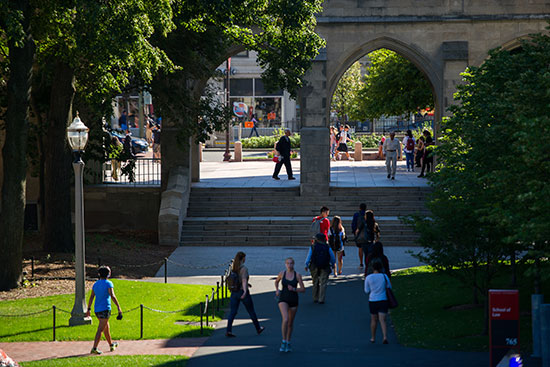Record Financial Year for University
Bond rating agency Moody’s upgrades BU’s outlook

BU has had a string of record-breaking years financially, generating $157.5 million in operating reserves during fiscal 2016. Photo by Cydney Scott
Boston University ended the last fiscal year with record operating reserves and a record sum of cash gifts from a record number of alumni. Those results cap a string of strong years that have in part led Moody’s Investors Service to revise BU’s rating outlook from “stable” to “positive.”
The University generated $157.5 million in operating reserves when fiscal 2016 closed June 30, a 12 percent increase over the previous year. Those funds support the academic mission of BU, with approximately $100 million earmarked to support physical plant renovations and expansion across the University, such as the Center for Integrated Life Sciences & Engineering and the new studio theater and production and education facility for the College of Fine Arts, says Derek Howe, BU’s vice president for budget and capital planning.
The remainder of these reserves are funds generated as part of revenue-sharing agreements with the University’s various schools and colleges and provide support to the academic and research mission of the University. Examples include upcoming initiatives such as the General Education program, the common core required of undergraduates across all academic programs, starting with the freshman class entering in 2018, Howe says.
“Fiscal 2014, 2015, 2016 were all record years for reinvestment into the University,” he says.
Martin Howard, senior vice president, chief financial officer, and treasurer, says BU’s financial health reflects the University’s growing reputation and increased interest on the part of student applicants—as witnessed by the growth and quality of the undergraduate applicant pool and the recent growth in graduate enrollments—as well as its fundraising and sponsored research funding (which mostly comes from the federal government). More than half of the University’s operating revenues is from net tuition and fees.
Sponsored research revenue totaled $307 million in fiscal year 2016, a small increase over the previous year. That’s noteworthy “in this extremely competitive environment for research funding,” Howard says. BU’s admission in 2012 to the Association of American Universities, a consortium of 62 leading public and private research universities, bolstered the University’s positioning for research support, he says.
Howe says that BU’s efforts at operating efficiently also played a part in its financial situation, adding, “We are always looking for continuous improvement.”
The University’s financial performance contrasts with that of many peers. “The trends at Boston University are more impressive in the context of stagnant or declining operating trends for many rated institutions of higher education,” says Howard.
Moody’s revised outlook for BU signals the potential for a credit rating upgrade if these financial trends continue. The credit rating measures an institution’s ability to repay borrowed capital; the higher the rating, the easier it is for the University to access debt capital at lower borrowing costs. BU’s current rating is A1. (Moody’s ratings range from Aaa to C, with numbers added within each grade for further differentiation.)
In revising its assessment of the University’s rating outlook, Moody’s report cited BU’s “improved ability to invest in strategic initiatives and grow financial reserves through strengthening cash flow, monetization of real estate, and fundraising combined with a moderate reduction of liquidity risks in its debt portfolio” while noting “its organizational culture of continuous improvement and benchmarking for driving operational efficiencies and strategic use of resources.”
On the fundraising front, BU enjoyed a record $157 million in cash gifts from more than 51,000 donors in fiscal 2016, says Scott Nichols, senior vice president for development and alumni relations. Nichols says fiscal 2017 is off to a hotter than usual start as well. The first quarter of every year, July through September, “is usually the worst of the year for us,” he says. Fundraising during the first quarter in recent years averaged $14 million. This year, he says, BU raised $35 million, with a big boost from two large gifts over the summer of $8 million and $10 million.
Since April 2010, all gifts to the University have been part of its comprehensive Campaign for BU, with a goal of $1.5 billion by its end in 2019. When the last fiscal year closed in June, $1.045 billion had been raised.
Nearly 300,000 gifts have been given to the campaign so far, including 167 gifts of $1 million or more. That exceeds the number of gifts that size given to BU between its founding in 1839 and the start of the campaign, Nichols says.
BU recently made the CASE 50, the list of the world’s top fundraising universities compiled by the Council for the Support and Advancement of Education. To crack the list, schools must meet several criteria, among them having had a $1 billion campaign. That was the University’s original goal, and when it was met in April, the Campaign for BU upped its target.
Comments & Discussion
Boston University moderates comments to facilitate an informed, substantive, civil conversation. Abusive, profane, self-promotional, misleading, incoherent or off-topic comments will be rejected. Moderators are staffed during regular business hours (EST) and can only accept comments written in English. Statistics or facts must include a citation or a link to the citation.